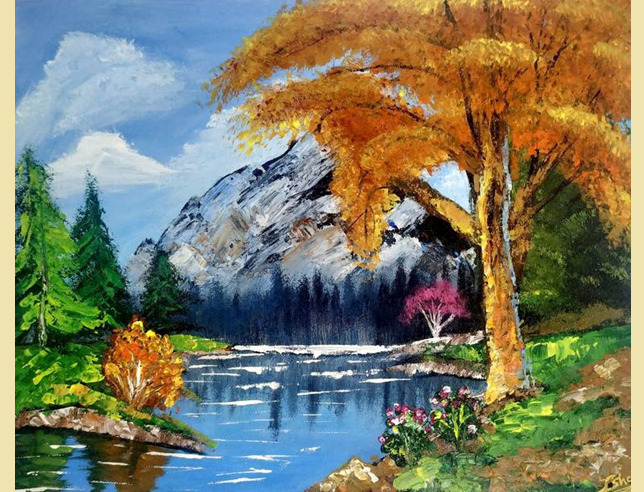Oil painting is one of the most revered and enduring art forms in history. Its rich textures, vibrant colors, and ability to capture light and emotion have made it a favorite among artists for centuries. But where did this medium originate, and how has it evolved over time? Let’s dive into the fascinating background of oil painting and explore why it continues to captivate artists and art lovers alike.
The Origins of Oil Painting
The roots of oil painting can be traced back to ancient civilizations. Early forms of oil-based paints were used by artists in Afghanistan as early as the 7th century, but it wasn’t until the Renaissance that oil painting truly flourished. The technique gained prominence in Europe during the 15th century, thanks to the innovations of Flemish painters like Jan van Eyck. Van Eyck is often credited with perfecting the use of oil paints, creating works with unprecedented depth, detail, and luminosity.
Before oil paints, artists primarily used tempera (egg-based paints) and frescoes. While these mediums had their merits, they lacked the versatility and durability of oil paints. Oil painting allowed artists to work more slowly, layer colors, and achieve a level of realism that was previously unattainable.
The Renaissance: A Golden Age for Oil Painting
The Renaissance marked a turning point for oil painting. Artists like Leonardo da Vinci, Rembrandt, and Titian embraced the medium, pushing its boundaries and creating masterpieces that still inspire awe today. The ability to blend colors, create subtle transitions, and build up layers of glaze gave oil paintings a lifelike quality that was revolutionary.
One of the most famous examples of Renaissance oil painting is Leonardo da Vinci’s Mona Lisa. The painting’s soft transitions between light and shadow, known as sfumato, showcase the unique capabilities of oil paints. Similarly, Rembrandt’s use of chiaroscuro (the contrast between light and dark) demonstrated how oil painting could evoke emotion and drama.
The Evolution of Oil Painting Techniques
Over the centuries, oil painting techniques have continued to evolve. During the Baroque period, artists like Caravaggio used oil paints to create dramatic, theatrical scenes. In the 19th century, the Impressionists, such as Claude Monet and Vincent van Gogh, broke away from traditional methods, using bold brushstrokes and vibrant colors to capture the fleeting effects of light and atmosphere.
The 20th century saw even more experimentation, with artists like Pablo Picasso and Jackson Pollock pushing the boundaries of what oil painting could be. From abstract expressionism to hyper-realism, oil painting has proven to be an incredibly versatile medium, capable of adapting to the changing tastes and styles of each era.
Why Oil Painting Remains Popular Today
Despite the rise of digital art and other modern mediums, oil painting continues to hold a special place in the art world. Here are a few reasons why:
- Timeless Beauty: The depth and richness of oil paints are unmatched. The way light interacts with the layers of paint creates a luminous effect that is difficult to replicate with other mediums.
- Versatility: Oil paints can be used in a variety of ways, from thin glazes to thick impasto techniques. This versatility allows artists to express their creativity in countless ways.
- Durability: When properly cared for, oil paintings can last for centuries. Many of the world’s most famous artworks are oil paintings that have stood the test of time.
- Tactile Experience: There’s something deeply satisfying about the physical act of painting with oils. The texture of the paint, the smell of the linseed oil, and the ability to manipulate the medium directly on the canvas make it a uniquely immersive experience.
Getting Started with Oil Painting
If you’re inspired to try your hand at oil painting, here are a few tips to get started:
- Invest in Quality Materials: While oil painting can be expensive, investing in good-quality paints, brushes, and canvases will make a big difference in your results.
- Learn the Basics: Start with simple exercises to understand how oil paints behave. Experiment with blending, layering, and creating different textures.
- Be Patient: Oil paints take longer to dry than other mediums, so patience is key. Use this to your advantage by taking your time to refine your work.
- Study the Masters: Analyze the works of great oil painters to learn their techniques and gain inspiration.
Conclusion
Oil painting is more than just an art form—it’s a testament to human creativity and the desire to capture the beauty of the world around us. From its humble beginnings to its status as a cornerstone of art history, oil painting has a rich and storied background that continues to inspire artists today. Whether you’re a seasoned painter or a curious beginner, there’s no better time to explore the timeless allure of oil painting.
So, pick up a brush, dip it into that rich, buttery paint, and let your creativity flow. Who knows? You might just create the next masterpiece that stands the test of time.

